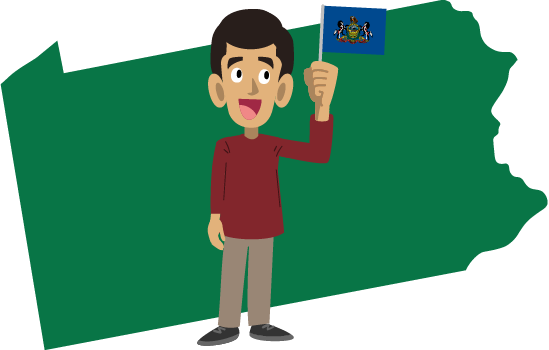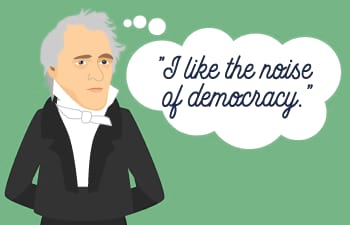Why is Pennsylvania called the Keystone State? What is Pennsylvania’s capital? Who was the only U.S. President from Pennsylvania? These are just some of the questions we will answer in our homeschool unit study supplement highlighting Pennsylvania.
In this study, we’re exploring another of the original 13 colonies, Pennsylvania, including historical facts about Pennsylvania, plenty of info about the state’s geography, and even some fun things for children to do in the state. You’ll also enjoy our collection of online Pennsylvania learning games which will challenge your homeschoolers to test what they’ve learned via interactive play.
As part of Time4Learning’s full series of United States unit study supplements, this particular state study can be used as part of your geography and/or history lessons, or just a neat supplement to your regular schedule. You can also download our list of PreK-12 interactive activities that align with your study of interesting facts about Pennsylvania. Are you ready to learn more about this state with such a rich history? Then let’s get studying!
Pennsylvania Fast Facts
| Became a Colony |
1681 |
|---|---|
| Became a State |
December 12, 1787 |
| Order it Joined the Union | 2nd state |
| State Capital |
Harrisburg |
| State Abbreviation |
PA |
| Border States | |
| State Flag |  |
| State Song | |
| State Nicknames |
|
| Notable Pennsylvanians |
|
Historical Facts About Pennsylvania
The area now known as Pennsylvania was originally home to many different native peoples including the Seneca tribe, the Lenape, and the Susquehannock. The first European known to explore the region was French explorer Etienne Brule who explored the Great Lakes between 1612 and 1615. Eventually, though, the area became one of the original thirteen colonies. Let’s look at some of the most interesting facts about the Pennsylvania colony for children.
- The Swedish were the first people to colonize Pennsylvania and originally called it Nya Sverige (New Sweden).
- William Penn, officially colonized Pennsylvania in 1681.
- Because the land was granted to Penn by King Charles II due to a debt owed to Penn’s father, Admiral Penn, the colony was named in his honor.
- Pennsylvania was the only colony, of the original thirteen, that didn’t border water.
- The original government of the colony was designed chiefly to grant religious freedom to the Quakers, of whom Penn was a leader.
Pennsylvania played a critical part in the American Revolution, as well. The First and Second Continental Congress meetings were both held in Philadelphia, and the Declaration of Independence was drawn up and signed there. The Articles of Confederation that designated the thirteen colonies as an independent nation was drafted in York, Pennsylvania. Even our country’s constitution was written in Pennsylvania! Pennsylvania became a state when it ratified the constitution in 1787, making it the second state to join the Union. That certainly wasn’t the end of Pennsylvania’s history, however. Here are some more interesting Pennsylvania state facts.
- The Civil War battle of Gettysburg was fought in PA in 1863.
- The country’s first zoo was established in Pennsylvania by Benjamin Franklin.
- The first computer ever used in the U.S. was in Pennsylvania in 1946.
- It is one of only four states called a “commonwealth” which means the state puts a priority on representative government.
- A keystone is the part of a stone arch that keeps all the other stones held in place. Because of its important role in the founding of the country, Pennsylvania is nicknamed the “Keystone State.”
- The world’s first motion picture theater opened in Pittsburgh in 1905.
- In 1974, the firefly was named Pennsylvania’s official state insect.
Geographical Facts About Pennsylvania
Now that we’ve looked at some of the most interesting insights into Pennsylvania’s history, let’s turn our attention to the environment of the state. Explore a map of the state and then print out our map of Pennsylvania to markup with your child. Here’s a small survey of some of the things your homeschoolers will find fascinating about Pennsylvania’s geography.
- The Monongahela River in Western PA has a very unique feature: it flows north!
- A small part of the state also borders the Canadian province of Ontario.
- The town of Punxsutawney, PA is legendary because its most famous resident, a groundhog named Phil, is said to predict the weather each year on Groundhog Day.
- One borough in Pennsylvania has been on fire for over 50 years. A coal mine in Centralia, PA caught on fire in 1962 and has been burning underground ever since!
- The Ringing Rocks in Bucks County are a unique geographical feature because they resonate like a bell when struck (and geologists aren’t completely sure why).
- In mid-June, the sunny mountainsides of Pennsylvania become washed in pink blooms. This display led to the designation of the Mountain Laurel as the state flower.
Pennsylvania State Map
Download our FREE Pennsylvania state map printable. Use it as a coloring page or use it to plot the state’s geographical features.
Activities for Children in Pennsylvania
If you homeschool in the state of Pennsylvania, you may or may not be aware of all the great day trips that will offer your families opportunities for both recreation and learning. If you are visiting the state, this list will be especially helpful as well. Enhance your Pennsylvania unit study with these field trip ideas.
- Fallingwater (Ohiopyle) — For any students interested in art or architecture, a visit to this home of architect Frank Lloyd Wright is a must. The home is built directly atop a waterfall! There are opportunities for organized field trips, or you can bring any children of 6 years or older on the individual guided tours.
- Lost River Caverns (Hellertown) — This destination will allow you to study geology up close and personal. In addition to a tour of the cave, you’ll also want to explore the nature trail which includes stations explaining the terrain of the area and features of the cave itself.
- Punxsutawney Weather Discovery Center (Punxsutawney) — As you might expect, in a town famous for a weather-predicting groundhog, there sits a museum dedicated to weather education. This is a highly interactive field trip designed to inspire future meteorologists.
- Salt Springs Park (Montrose) — Learn about both the cultural and natural heritage of the Susquehanna County region at this 405 acre park. There are interpretive programs for both children and adults on subjects such as stream adaptations, forest communities, wetlands and watersheds, and meadow biodiversity.
- U.S. Mint (Philadelphia) — The manufacturing of coins is a fascinating process to learn about, and there is no better place to do that than the location of our country’s original Mint facility.
For additional field trip options in Pennsylvania, visit A2Z Homeschooling’s Pennsylvania Field Trips with Kids page.
Pennsylvania Freebies and Deals for Homeschoolers
- Adventure Aquarium (Philadelphia) — during their dedicated Homeschool Weeks, you and your family can save up to 50% off tickets.
- Liberty Bell Center (Philadelphia)— Learn about the Liberty Bell’s important role in American History at this completely FREE, year-round site.
- First National Bank Museum (Columbia) — student entrance is only $5 and children 8 years of age and younger get in FREE!
- Hershey Story Museum (Hershey) — offers educational programs for homeschoolers all through the school year and admission for groups of 10 or more is only $17 per student (one free chaperone for every 5 students).
- Pennsylvania Renaissance Faire (Manheim) — homeschool groups of 10 or more are eligible for the student rate on Student Days at the Faire (usually in October of each year).








